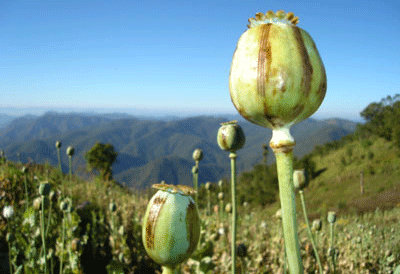Burma Army Continues to Use the Drugs Trade as a Weapon of War
By Burma Partnership • October 14, 2014 A new report by Kachin Women’s Association – Thailand (KWAT), “Silent Offensive: How Burma Army Strategies are Fuelling the Kachin Drug Crisis” outlines the severity of the drug problem in northern Burma as well as the complicity of the government in the trade. The report shows how the government is using opium-growing militia forces in its operations against the Kachin Independence Army (KIA) as part of a deal in which these militias are given free rein to produce and sell heroin and other narcotics.
A new report by Kachin Women’s Association – Thailand (KWAT), “Silent Offensive: How Burma Army Strategies are Fuelling the Kachin Drug Crisis” outlines the severity of the drug problem in northern Burma as well as the complicity of the government in the trade. The report shows how the government is using opium-growing militia forces in its operations against the Kachin Independence Army (KIA) as part of a deal in which these militias are given free rein to produce and sell heroin and other narcotics.
Thus, as the report points out, it is members of either Burma Army controlled Border Guard Forces (BGF) such as the New Democratic Army – Kachin (NDAK), a splinter group of the Kachin Independence Organization (KIO) that became a BGF in 2009, or People’s Militia Forces (PMF) that are heavily involved in offensives against the KIO. Land that is taken by the Burma Army and its proxy forces is then allocated to BGFs/PMFs to utilize however they like. This is often opium cultivation, heroin production and methamphetamine production. To make matters worse these are areas under which the KIO had previously been involved in anti-drug activities but since BGFs or PMFs have taken over, opium cultivation has increased greatly in areas such as Nampaka in northern Shan State and Chipwi in Kachin State.
It is not only armed actors who are complicit in this appalling state of affairs. Government officials benefit from taxing opium growers while leaders or former leaders of BGFs and PMFs heavily involved in the trade are members of parliament. For example, the main opium growing areas in Kachin State, Chiwpwi and Waingmaw, which the NDAK and Burma Army control, are represented in the Union Parliament by the former NDAK leader, Zakhung Ting Ying. The report explains that “in Kachin-populated regions of northern Shan State, the main opium growing areas are in Muse District under the control of the Burma Army and thirteen government People’s Militia Forces, three of whose leaders are MPs in the Shan State Assembly.” In Ta’ang areas, a local PMF, the ‘Pansay Militia’ which is led by Kyaw Myint controls the opium trade around Namkan Township. Kyaw Myint is also an MP for the ruling Union Solidarity and Development Party (USDP).
The complicity of government controlled BGFs in the drug trade is not limited to Kachin State. In a report released in March 2014, Karen Human Rights Group note “an increase in the production and sale of methamphetamines by Tatamadaw-Border Guard Forces (BGF) soldiers in Hpapun and Hpa-an districts.”
Thus the involvement of BGFs and PMFs cannot be seen as isolated to the war in Kachin and northern Shan State, but is a systematic and widespread policy. So while the government announced a new policy and action plan for next year to combat the drugs trade, working together with the UN Office on Drugs and Crime (UNODC), including softer penalties for drug users, this is inadequate. The structure of the drugs trade, including the use of drugs as a tool in the war against ethnic nationalities who are armed for political purposes, is not being addressed.
The narcotics trade is being used as a political play to consolidate power by the Burma Government and Burma Army. There is no real political will to stop this lucrative business, but the victims are the people who become dependent on opium, heroin, or methamphetamines, either for their livelihood or because they become addicted, the social effects of which are extremely destructive. The international community must realize that the authorities are very much complicit in the trade and must apply appropriate pressure. If the politics of this issue are ignored, the root causes of why Burma’s opium production is second only to Afghanistan and has been increasing every year since 2006 will never be addressed and any kind of eradication program will be rendered useless. After all, it is not just the domestic market where the drugs produced in Burma reach, and thus it is the responsibility of regional and international actors too.
Tags: Border Guard Force, Burma Army, Burma Government, Drugs, Kachin, Kachin Independence Army, Kachin Independence Organization, Kachin Women's Association – Thailand, New Democratic Army – Kachin, Opium, People’s Militia Forces, Shan, Union Solidarity and Development Party, United Nations Office on Drug and CrimeThis post is in: Blog
Related PostsBurma Army Displays Blatant Disregard for 21st Century Panglong Peace Process
Karen State September 2016 Conflict: The Real Motivations Behind Renewed War
Burma Army’s actions in Karen State threaten to expand fighting, endangering peace process and displaced people’s return
Hpa-an Situation Update: Hlaingbwe and Paingkyon townships, March to May 2016
Legal Analysis Statement on current armed conflict in Karen State from the perspective of human rights and the rule of law vis-a-vis the Nationwide Ceasefire Agreement









 All posts
All posts